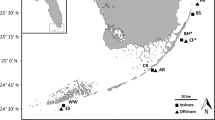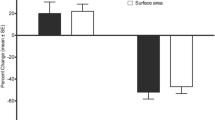Abstract
Massive colonies of the reef-building coral genus Porites were collected at inshore, midshelf and shelf-edge reefs in the central section of the Great Barrier Reef in November 1987. These colonies were comprised of 4 species: P. lobata, P. lutea, P. solida and P. mayeri. X-radiographs made of skeletal slices cut from the skeletons displayed the annual density-banding pattern characteristic of massive corals, and appeared to show corallites within each slice. The average age of the 36 colonies was 41±12 yr (mean±SD). The images of corallites displayed by the X-radiographs were not images of actual corallites, but approximated the position and size of actual corallites. Consequently, X-radiographs provide information about the formation and growth trajectories of corallites, and about the history of the polyps which deposited the corallites. Individual corallites were always normal to the growth surface. The growth surface of the colonies became bumpy when they reached 50 to 80 mm in height and, as a result, corallites took on a fan-shaped arrangement within a bump. New corallites were initiated at the summit of each bump and grew upwards and outwards. Thus, growth of colonies resulted in corallites becoming increasingly displaced from the summit of a bump. The X-radiographs showed that corallite growth becomes occluded at the bottom of valleys between adjacent bumps. Corallite growth then stops and the associated polyps are probably resorbed. Annual density banding showed that the average age of polyps in these colonies was 2 to 3 yr, average life expectancy 5 yr, and that no polyp was likely to be older than 8 yr. Small but significant variations in polyp longevity between corals from different reefs were probably associated with significant differences in bumpiness of growth surfaces. Even in Porites colonies which have been growing for several centuries, polyp longevity is likely to be 5 yr.
Similar content being viewed by others
Literature cited
Barnes, D. J. (1973). Growth in colonial scleractinians. Bull. mar. Sci. 23:280–298
Barnes, D., Lough, J. (1992). Systematic variations in the depth of skeleton occupied by coral tissue in massive colonies of Porites from the Great Barrier Reef. J. exp. mar. Biol. Ecol. 159: 113–128
Barnes, D. J., Lough, J. M., Tobin, B. J. (1989). Density measurements and the interpretation of X-radiographic images of slices of skeleton from the colonial hard coral Porites. J. exp. mar. Biol. Ecol. 131: 45–60
Buddemeier, R. W., Kinzie, R. A. (1976). Coral growth. Oceanogr. mar. Biol. A. Rev. 14: 183–225
Buddemeier, B. W., Maragos, J. E., Knutson, D. W. (1974). Radiographic studies of reef coral exoskeletons: rates and patterns of coral growth. J. exp. mar. Biol. Ecol. 14: 179–200
Darke, W. M. (1991). Growth and growth form in the massive coral Porites. Ph. D. dissertation. James Cook University, Townsville, Qld, Australia
Dodge, R. E., Aller, R. C., Thomson, J. (1974). Coral growth related to resuspension of bottom sediments. Nature, Lond. 247: 574–576
Dodge, R. E., Thomson, J. (1974). The natural radiochemical and growth records in contemporary hermatypic corals from the Atlantic and the Caribbean. Earth planet. Sci. Lett. 23: 313–322
Harrison, P. L., Wallace, C. C. (1990). Reproduction, dispersal and recruitment of scleractinian corals. In: Dubinsky Z. (ed.) Coral reefs. Ecosystems of the world. Vol. 25. Elsevier Science Publishers B. V., Amsterdam, p. 133–207
Hudson, J. H., Shinn, E. A., Halley, R. B., Lidze, B. (1976). Sclerochronology: a tool for interpreting past environments. Geology (Boulder, Colorado) 4: 361–364
Isdale, P. J. (1977). Variation in growth rate of hermatypic corals in a uniform environment. Proc. 3rd int. coral reef Symp. 2: 403–408 [Taylor, D. L. (ed.) Rosenstiel School of Marine and Atmospheric Science, University of Miami]
Knutson, D. W., Buddemeier, R. W., Smith, S. V. (1972). Coral chronometers: seasonal bands in reef corals. Science, N.Y. 177: 270–272
Lough, J. M., Barnes, D. J. (1990). Intra-annual timing of density band formation of Porites coral from the central Great Barrier Reef. J. exp. mar. Biol. Ecol. 135: 35–57
Lough, J. M., Barnes, D. J. (1992). Comparison of skeletal density variations in Porites from the central Great Barrier Reef. J. exp. mar. Biol. Ecol. 155: 1–25
Loya, Y. (1976). Skeletal regeneration in a Red Sea scleractinian coral population. Nature, Lond. 261: 490–491
Macintyre, I. G., Smith, S. V. (1974). X-radiographic studies of skeletal development in coral colonies. Proc. 2nd int. coral Reef Symp. 2: 277–287 [Cameron, A. M. et al. (eds.) Great Barrier Reef Committee, Brisbane]
McCloskey, L. R., Muscatine, L. (1984). Production and respiration in the Red Sea coral Stylophora pistillata as a function of depth. Proc. R. Soc. (Ser B) 222: 215–230
Meyer, J. L., Schultz, E. T. (1985). Tissue condition and growth rate of corals associated with schooling fish. Limnol. Oceanogr. 30: 157–166
Muscatine, L., McCloskey, L. R., Loya, Y. (1985). A comparison of the growth rates of zooxanthellae and animal tissue in the Red Sea coral Stylophora pistillata. Proc. 5th. int. coral Reef Congr. 6: 119–123. [Gabrié, C. et. al. (eds.) Antenne Museum-EPHE, Moorea, French Polynesia]
Moore, W. S., Krishnaswami, S. (1974). Correlation of X-radiography revealed banding in corals with radiometric growth rates. Proc. 2nd int. coral Reef Symp. 2: 269–276. [Cameron, A. M. et al. (eds.) Great Barrier Reef Comittee, Brisbane]
Motoda, S. (1940). A study of growth rate in the massive reef coral Goniastrea aspera. Palao trop. biol. Stn. Stud. 2: 1–6
Noshkin, T. E., Wong, K. M., Eagle, R. J., Gatrousis, C. (1975). Transuranics and other radionuclides in Bikini Lagoon: concentration data retrieved from aged coral sections. Limnol. Oceanogr. 20: 729–742
Patzold, J. (1984). Growth rhythms recorded in stable isotopes and density bands in the reef coral Porites lobata (Cebu, Philippines). Coral Reefs 3: 87–90
Potts, D. C., Done, T. J., Isdale, P. J., Fisk, D. A. (1985). Dominance of a coral community by the genus Porites (Scleractinia). Mar. Ecol. Prog. Ser. 23: 79–84
Stearn, C. W., Scoffin, T. P., Martindale, W. (1977). Calcium carbonate budget of a fringing reef on the west coast of Barbados. Part I. Zoning and productivity. Bull. mar. Sci. 27: 479–510
Stephenson, T. A. (1931). Development and formation of colonies of Pocillopora and Porites. Part 1. Scient. Rep. Gt Barrier Reef Exped. 3: 129–134
Veron, J. E. N. (1986). Corals of Australia and the Indo-Pacific. Angus & Robertson. North Ryde, N.S.W., Australia
Veron, J. E. N., Pichon, M.: (1982). Scleractinia of eastern Australia. Part IV. Family Poritidae. Monograph Ser. Aust. Inst. mar. Sci. 5: 1–159
Author information
Authors and Affiliations
Additional information
Communicated by G. F. Humphrey, Sydney
Rights and permissions
About this article
Cite this article
Darke, W.M., Barnes, D.J. Growth trajectories of corallites and ages of polyps in massive colonies of reef-building corals of the genus Porites . Marine Biology 117, 321–326 (1993). https://doi.org/10.1007/BF00345677
Received:
Accepted:
Issue Date:
DOI: https://doi.org/10.1007/BF00345677




